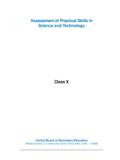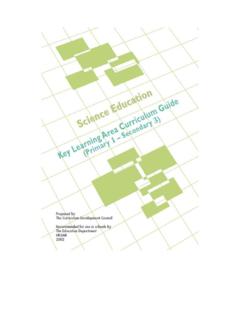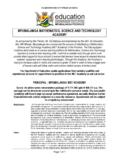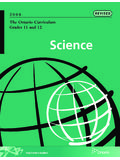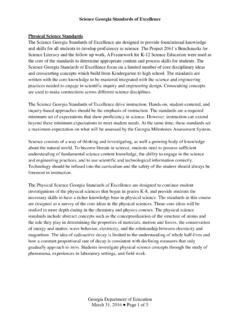Transcription of DESIGN AND GCSE TECHNOLOGY - …
1 GCSEDESIGN ANDTECHNOLOGY8552 SpecificationFor teaching from September 2017 onwardsFor GCSE exams in 2019 onwardsVersion 12 January 2017 Contents1 Why choose AQA for GCSE DESIGN and TECHNOLOGY Support and resources to help you teach52 Specification at a Subject Assessments73 Subject Core technical principles Specialist technical Designing and making principles284 Scheme of Aims and learning Assessment Assessment Non-exam assessment 385 Non-exam assessment administration Supervising and Avoiding Teacher Internal Submitting Factors affecting individual Keeping students' After moderation526 General Entries and Overlaps with other Awarding grades and reporting Re-sits and shelf Previous learning and Access to assessment: diversity and Working with AQA for the first Private Use of calculators55 GCSE DESIGN and TECHNOLOGY 8552. GCSE exams June 2019 onwards. Version 12 January 2017 Visit for the most up-to-date specification, resources, support and administration 37 Appendix 1: Links to maths Links to Links to science58 Are you using the latest version of this specification?
2 You will always find the most up-to-date version of this specification on our website We will write to you if there are significant changes to the Visit for the most up-to-date specification, resources, support and administration1 Why choose AQA for GCSE DESIGN and TechnologyGCSE DESIGN and TECHNOLOGY will prepare students to participate confidently and successfully inan increasingly technological world. Students will gain awareness and learn from wider influenceson DESIGN and TECHNOLOGY including historical, social, cultural, environmental and economicfactors. Students will get the opportunity to work creatively when designing and making and applytechnical and practical GCSE allows students to study core technical and designing and making principles, includinga broad range of DESIGN processes, materials techniques and equipment. They will also have theopportunity to study specialist technical principles in greater can find out about all our DESIGN and TECHNOLOGY qualifications at Support and resources to help you teachWe ve worked with experienced teachers to provide you with a range of resources that will helpyou confidently plan, teach and prepare for Teaching resourcesVisit to see all our teaching resources.
3 They include: teaching guidance including lesson plans, and suggested teaching strategies to provide youwith practical guidance to help deliver this specification non-exam assessment example materials and a dedicated subject adviser for every school orcollege to help you understand our expectations for this part of the assessment sample schemes of work to help you plan your course with confidence textbooks tailored to our specification and approved by AQA training courses to help you deliver AQA DESIGN and TECHNOLOGY qualifications subject expertise courses for all teachers, from newly qualified teachers who are just gettingstarted to experienced teachers looking for fresh Preparing for examsVisit for everything you need to prepare for our exams, including: past papers, mark schemes and examiners reports specimen papers and mark schemes for new courses Exampro: a searchable bank of past AQA exam questions example student answers with examiner DESIGN and TECHNOLOGY 8552.
4 GCSE exams June 2019 onwards. Version 12 January 2017 Visit for the most up-to-date specification, resources, support and administration 5 Analyse your students' results with Enhanced Results Analysis (ERA)Find out which questions were the most challenging, how the results compare to previous yearsand where your students need to improve. ERA, our free online results analysis tool, will help yousee where to focus your teaching. Register at information about results, including maintaining standards over time, grade boundaries and ourpost-results services, visit your skills up-to-date with professional developmentWherever you are in your career, there s always something new to learn. As well as subjectspecific training, we offer a range of courses to help boost your skills. Improve your teaching skills in areas including differentiation, teaching literacy and meetingOfsted requirements. Prepare for a new role with our leadership and management can attend a course at venues around the country, in your school or online whatever suitsyour needs and availability.
5 Find out more at and supportVisit our website for information, guidance, support and resources at you'd like us to share news and information about this qualification, sign up for emails andupdates at , you can call or email our subject team : 0161 957 33346 Visit for the most up-to-date specification, resources, support and administration2 Specification at a glanceThis qualification is linear. Linear means that students will sit all their exams and submit all theirnon-exam assessment at the end of the Subject content1. Core technical principles (page 9)2. Specialist technical principles (page 19)3. Designing and making principles (page 28) AssessmentsPaper 1 What's assessed Core technical principles Specialist technical principles Designing and making principlesHow it's assessed Written exam: 2 hours 100 marks 50% of GCSEQ uestionsSection A Core technical principles (20 marks)A mixture of multiple choice and short answer questions assessing a breadth of technicalknowledge and B Specialist technical principles (30 marks)Several short answer questions (2 5 marks) and one extended response to assess a more indepth knowledge of technical C Designing and making principles (50 marks)A mixture of short answer and extended response DESIGN and TECHNOLOGY 8552.
6 GCSE exams June 2019 onwards. Version 12 January 2017 Visit for the most up-to-date specification, resources, support and administration 7 Non-exam assessment (NEA)What's assessedPractical application of: Core technical principles Specialist technical principles Designing and making principlesHow it's assessed Non-exam assessment (NEA): 30 35 hours approx 100 marks 50% of GCSETask(s) Substantial DESIGN and make task Assessment criteria: Identifying and investigating DESIGN possibilities Producing a DESIGN brief and specification Generating DESIGN ideas Developing DESIGN ideas Realising DESIGN ideas Analysing & evaluating In the spirit of the iterative DESIGN process, the above should be awarded holistically wherethey take place and not in a linear manner Contextual challenges to be released annually by AQA on 1 June in the year prior to thesubmission of the NEA Students will produce a prototype and a portfolio of evidence Work will be marked by teachers and moderated by AQA8 Visit for the most up-to-date specification, resources, support and administration3 Subject contentOur GCSE DESIGN and TECHNOLOGY specification sets out the knowledge, understanding and skillsrequired to undertake the iterative DESIGN process of exploring, creating and evaluating.
7 Themajority of the specification should be delivered through the practical application of this knowledgeand and themes have been grouped to help you teach the specification, but these are notintended as a route through the specification, you can teach the content in any order. The subjectcontent has been split into three sections as follows: Core technical principles Specialist technical principles Designing and making principlesCore technical principles (page 9) covers core technical principles and all content must betaught. Specialist technical principles (page 19) covers specialist technical principles wherestudents will go into greater depth. Each principle should be taught through at least one materialcatergory or system. Designing and making principles (page 28) covers DESIGN and makingprinciples and all content in this section must be specification content is presented in a two column format. The left hand column contains thespecification content all students must cover, and forms the basis for the assessments.
8 Thiscolumn sets out what students must know and understand to ensure they study the topic inappropriate depth and gives teachers the parameters in which the subject will be must also demonstrate mathematical and scientific knowledge and understanding, inrelation to DESIGN and TECHNOLOGY . The right hand column throughout this section illustrates wherethe maths and science skills and knowledge can be applied to the wider DESIGN and technologycontent. These are examples of where these skills can be applied and are not intended to maths and science skills and knowledge as required by the DfE, are set out in Appendix 1:Links to maths and science (page 57) of this Core technical principlesIn order to make effective DESIGN choices students will need a breadth of core technical knowledgeand understanding that consists of: new and emerging technologies energy generation and storage developments in new materials systems approach to designing mechanical devices materials and their working of this section must be taught and all will be DESIGN and TECHNOLOGY 8552.
9 GCSE exams June 2019 onwards. Version 12 January 2017 Visit for the most up-to-date specification, resources, support and administration New and emerging technologiesStudents must know and understand the impact of new and emerging technologies oncontemporary and potential future scenarios in relation to the following areas:IndustryContentPotential links to maths and scienceThe impact of new and emerging technologies on: the DESIGN and organisation of the workplaceincluding automation and the use of robotics buildings and the place of work tools and links to maths and scienceEnterprise based on the development of an effectivebusiness innovation: crowd funding virtual marketing and retail co-operatives fair links to maths and scienceThe impact of resource consumption on the planet: finite non finite disposal of into consideration the ecologicaland social footprint of links to maths and scienceHow TECHNOLOGY push/market pull affects job roles due to the emergence of newways of working driven by technological Visit for the most up-to-date specification, resources, support and administrationCultureContentPotential links to maths and scienceChanges in fashion and trends in relation to new andemergent people of different faiths and links to maths and scienceHow products are designed and made to avoidhaving a negative impact on others: DESIGN for disabled elderly different religious links to maths and sciencePositive and negative impacts new products have onthe environment: continuous improvement efficient working pollution global techniques and systemsContentPotential links to maths and scienceThe contemporary and potential future use of.
10 Automation computer aided DESIGN (CAD) computer aided manufacture (CAM) flexible manufacturing systems (FMS) just in time (JIT) lean DESIGN and TECHNOLOGY 8552. GCSE exams June 2019 onwards. Version 12 January 2017 Visit for the most up-to-date specification, resources, support and administration 11 How the critical evaluation of new and emerging technologies informs DESIGN decisionsContentPotential links to maths and scienceThat it is important to consider scenarios fromdifferent perspectives and considering: planned obsolescence DESIGN for maintenance ethics the factors and consideration ofecological and social Energy generation and storageStudents should understand how energy is generated and stored and how this is used as the basisfor the selection of products and power fuelsContentPotential links to maths and scienceHow power is generated from: coal gas for and against the selection of to choose appropriate powerContentPotential links to maths and scienceHow nuclear power is for and against the selection of to choose appropriate energyContentPotential links to maths and scienceHow power is generated from.










